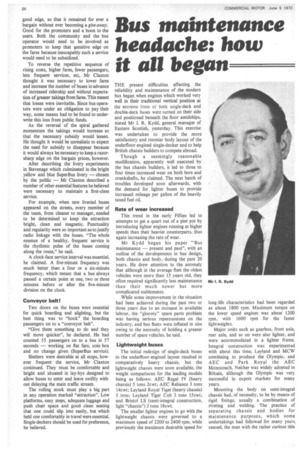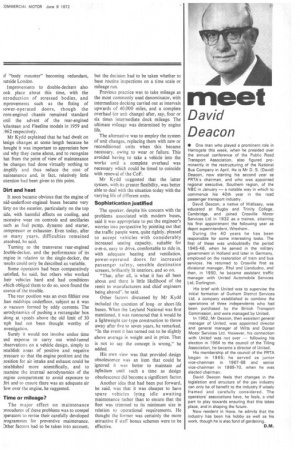Bus maintenance headache: how it all began
Page 38

Page 39

If you've noticed an error in this article please click here to report it so we can fix it.
THE present difficulties affecting the reliability and maintenance of the modern bus began when engines which worked very well in their traditional vertical position at the extreme front of both single-deck and double-deck buses were turned on their side and positioned beneath the floor amidships, stated Mr I. R. Kydd, general manager of Eastern Scottish, yesterday. This exercise was undertaken to provide the more satisfactory and roomier body layout of the underfloor-engined single-decker and to help British chassis builders to compete abroad.
Though a seemingly reasonable modification, apparently well executed by the bus chassis builders, it led to three to four times increased wear on both bore and crankshafts, he claimed. The next batch of troubles developed soon afterwards, with the demand for lighter buses to provide increased mileage per gallon of the heavily taxed fuel oil.
Rate of wear increased This trend in the early Fifties led to attempts to get a quart out of a pint pot by introducing lighter engines running at higher speeds than their heavier counterparts, thus again increasing the rate of wear.
Mr Kydd began his paper "Bus maintenance — present and past", with an outline of the developments in bus design, both chassis and body,,during the past 20 years. He drew attention to the anomaly that although in the average fleet the oldest vehicles were more than 15 years old, they often required significantly less maintenance than their much newer but more complicated stable mates.
While some improvement in the situation had been achieved during the past two or three years due to an increase in available labour, the "gloomy" spare parts problem was having serious repercussions on the industry, and bus fleets were inflated in size owing to the necessity of holding a greater number of spare vehicles, he said.
Lightweight buses The initial redesign of single-deck buses to the underfloorengined layout resulted in comparatively heavy chassis, but the lightweight chassis were soon available, the weight comparisons for the leading models being as follows: AEC Regal IV (heavy chassis) 5 tons 2cwt; AEC Reliance 3 tons 14cwt; Leyland Royal Tiger (heavy chassis) 5 tons; Leyland Tiger Cub 3 tons 15cwt; and Bristol LS (semi-integral construction, light "chassis") 3 tons 18cwt.
The smaller lighter engines to go with the lightweight chassis were governed to a maximum speed of 2200 to 2400 rpm, while previously the maximum desirable speed for long-life characteristics had been regarded as about 1800 rpm. Maximum torque on the lower speed engines was about 1200 rpm, with 1600 rpm for the faster lightweights.
Major units such as gearbox, front axle, rear axle, and so on were also lighter, and were accommodated in a lighter frame. Integral construction was experimented with about this time, Leyland and MCW combining to produce the Olympic, and AEC and Park Royal the AEC MonocoaCh. Neither was widely adopted in Britain, although the Olympic was very successful in export markets for many years.
Mounting the body on semi-integral chassis had, of necessity, to be by means of rigid fixings, usually a combination of riveting and welding. The practice of separating chassis and bodies for maintenance purposes, which some undertakings had followed for many years, ceased, the man with the rather curious title if "body mounter" becoming redundant, nits ide London.
Improvements to double-deckers also ook place about this time, with the ntroduction of stressed bodies, and mprovements such as the fitting of lower-operated doors, though the ront-engined chassis remained standard Lntil the advent of the rear-engined tlantean and Fleetline models in 1959 and ,962 respectively.
Mr Kydd explained that he had dwelt on lesign changes at some length because he bought it was important to appreciate how Lnd why they came about, and to recognize hat from the point of view of maintenance he changes had done virtually nothing to implify and thus reduce the cost of naintenance and, in fact, relatively little tttention had been given to this point.
Dirt and heat It soon became obvious that the engine of nid-underfloor-engined buses became very firty on the exterior, particularly on the top side, with harmful effects on cooling, and excessive wear on controls and ancillaries such as fuel pump, dynamo and starter, eompressor or exhauster. Even today, after 30 many years, difficulties remained .insolved, he said.
Turning to the transverse rear-engined louble-decker, and the performance of its engine in relation to the single-decker, the results could only be described as variable.
Some operators had been comparatively satisfied, he said, but others who worked heir vehicles hard and had conditions which obliged them to do so, soon found the source of the trouble.
The rear position was an even filthier one :han midships underfloor, subject • as it was ,0 vacuum formed by eddy currents. The aerodynamics of pushing a rectangular box along at speeds above the old limit of 30 nph had not been thought worthy of nvestigation.
Surely it would not involve undue time and expense to carry out wind-tunnel pbservations on a vehicle design, simply to establish areas of positive and negative pressure so that the engine position and the position for air intake and exhaust could be established more scientifically, and to examine the internal aerodynamics of the engine compartment to avoid exposure to lift and to ensure there was an adequate air low over the engine, he suggested.
Time or mileage?
The major effect on maintenance Procedures of these problems was to compel pperators to revise their carefully developed programmes for preventive maintenance. Dther factors had to be taken into account, but the decision had to be taken whether to base routine inspections on a time scale or mileage run.
Previous practice was to take mileage as the most commonly used denominator, with intermediate docking carried out at intervals upwards of 40.000 miles, and a complete overhaul (or unit change) after, say, four or six times intermediate dock mileage. The lulte.imate mileage was determined by engine if
The alternative was to employ the system of unit changes, replacing them with new or reconditioned units when this became necessary, owing to wear or failure. This avoided having to take a vehicle into the works until a complete overhaul was necessary which could be timed to coincide with renewal of the CoF.
Mr Kydd suggested that the latter system, with its greater flexibility, was better able to deal with the situation today with the varying life of different units.
Sophistication justified The speaker, despite his concern with the problems associated with modern buses, said it was appropriate to put the engineer's worries into perspective by pointing out that the traffic people were, quite rightly, pleased to accept vehicles with considerably increased seating capacity, suitable for o-m-o, easy to drive, comfortable to ride in, with adequate heating and ventilation, power-operated doors for increased passenger safety, sensible destination screens, brilliantly lit interiors, and so on.
"That, after all, is what it has all been about and there is little likelihood of the remit to manufacturers and chief engineers being altered", he said.
Other factors discussed by Mr Kydd
included the question of longor short-life buses. When the Leyland National was first mentioned, it was rumoured that it would be a lightweight car-type construction to throw away after five to seven years, he remarked. "In the event it has turned out to be slightly above average in weight and in price. That is not to say the concept is wrong," he added.
His own view was that provided design obsolescence was an item that could be ignored it was better to maintain ad infinitum until such a time as design obsolescence did become a significant factor.
Another idea that had been put forward, he said, was that it was cheaper to have spare vehicles lying idle awaiting maintenance rather than to ensure that the fleet was trimmed to its minimum size in relation to operational requirements. He thought the former was certainly the more attractive if staff bonus schemes were to be effective.




































































































